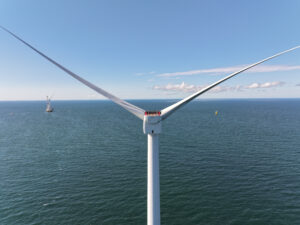Vineyard Wind 1 marks another milestone, sends first power to the grid just behind schedule

If you’re keeping score at home (why are you doing that when we have the internet?), take notes.
At 11:52PM on Tuesday, January 2, 2024, one turbine whirred to life and delivered power from Vineyard Wind 1 to the New England grid for the first time.
“Today, we begin a new chapter and welcome 2024 by delivering the first clean offshore wind power to the grid in Massachusetts,” said Avangrid CEO Pedro Azagra in a statement. “We’ve arrived at a watershed moment for climate action in the U.S., and a dawn for the American offshore wind industry.”
The roughly 5 megawatts of power delivered by Tuesday’s premier test represents only a small fraction of the project’s promised capacity- more than 800 MW- when Vineyard Wind 1 is fully operational later in 2024.
Avangrid and Copenhagen Infrastructure Partners (CIP) had previously promised first power before the end of 2023, ultimately missing that goal by a few days. Additional testing is expected both on and offshore in the coming weeks, and Vineyard Wind expects to have five turbines operating at full capacity by “early 2024.”
Power from the project interconnects to the New England grid in Barnstable, transmitted by underground cables that connect to a substation further inland on Cape Cod. Once completed, the project will consist of 62 wind turbines to generate 806 MW.
Vineyard Wind 1 began on-site construction in late 2021, achieved steel-in-the-water in June 2023, and completed the nation’s first offshore substation in July 2023. In October, the first E Haliade-X Wind Turbine Generator was installed, and the project got a $1.2 billion capital investment.
Vineyard Wind 1 is located 15 miles off the coast of Martha’s Vineyard and will be the first commercial-scale offshore wind project in the U.S. The project will generate electricity for more than 400,000 homes and businesses in the Commonwealth of Massachusetts under its long-term power purchase agreements (PPAs) with National Grid, Eversource, and Unitil.
Winds of change
When you’re done whistling the tune of the Scorpion song of the same name as the previous header, let’s acknowledge how much progress wind power is making stateside. Last month, Ørsted and Eversource’s South Fork Wind sent the first commercial wind power to the U.S. grid. So far, two of its 11-MW turbines are up. The second is undergoing testing, and soon it can begin producing power too. When the other ten are spinning and South Fork opens by early next year, it will be able to generate 132 megawatts of offshore wind energy to power more than 70,000 homes.
Large offshore wind farms have been making electricity for three decades in Europe, and more recently in Asia. The first U.S. offshore wind farm was supposed to be a project off the coast of Massachusetts known as “Cape Wind.” The application was submitted to the federal government in 2001. It failed after years of local opposition and litigation.
Despite recent milestones, wind power is struggling to retain a foothold. Ørsted announced it’s canceling two large offshore projects in New Jersey due to problems with supply chains, higher interest rates, and a failure to obtain the tax credits the company desired. Developers in New England also recently axed contracts too, saying their projects were no longer financially feasible. According to the Biden Administration, this series of setbacks for the offshore wind industry jeopardizes the country’s clean energy goals.
This article contains reporting from the Associated Press.



